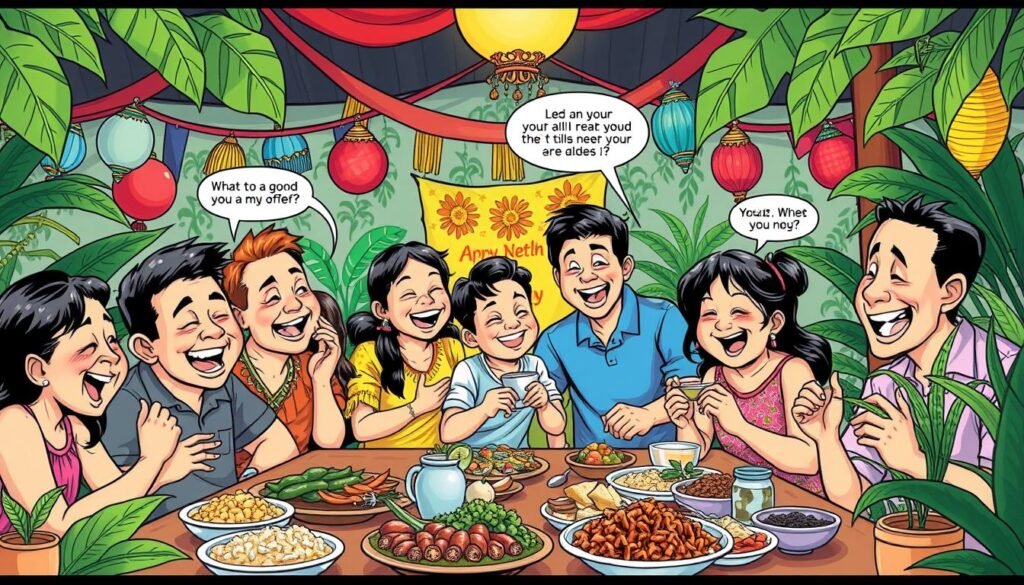What makes a single word in the Filipino language so powerful? It can change the whole meaning of a sentence. This word, “Naman”, shows the depth of Filipino culture and language. It’s used daily to add subtle meanings to conversations.
Linguists and cultural experts have studied “Naman”. They want to understand its role in the Filipino language and how it affects communication. As we look into “Naman”, we’ll explore language and word choice. We’ll see how this word is a key part of Filipino culture.
Key Takeaways
- The word “Naman” is a significant part of Filipino culture and language, and is often used to convey subtle nuances in meaning.
- The meaning of “Naman” can vary depending on the context in which it is used, making it a complex and multifaceted word.
- Understanding the word “Naman” is essential to grasping the complexities of the Filipino language and culture.
- The word “Naman” is a reflection of the Filipino values of subtlety and nuance in communication.
- The study of “Naman” can provide insights into the language and culture of the Philippines, and can help to promote cross-cultural understanding.
- The word “Naman” is an important part of the Filipino language, and its usage and meaning are worth exploring in depth.
Understanding the Meaning of “Naman”
The word “Naman” has several meanings. It can mean “of course,” “again,” and is used for contrast, emphasis, and softening requests. Its usage is flexible, showing different shades of meaning like “other”, “too”, “also”, “again”, or “on the other hand”.
For instance, “Naman” can soften commands, like “Tulungan mo naman ako” (Help me, please). It can also contrast opinions, such as “Mahilig ako sa kape. Ikaw naman sa tsaa” (I like coffee while you like tea). The phrase “na naman” means “again”, seen in “talo na naman tayo” (we lost again) and “Ako na naman?” (Me again?).
According to Filipino language resources, “Naman” adds emphasis or politeness in casual speech. It shows emotional expressions, like “Ang mahal naman!” (How expensive!) to express surprise or irritation.
Definitions and Context
The word “Naman” has various definitions, including:
- Used for contrast, emphasis, and softening requests
- Conveys subtle shifts in meaning, such as “other”, “too”, “also”, “again”, or “on the other hand”
- Used to soften commands, as in “Tulungan mo naman ako” (Help me, please)
Usage in Everyday Conversation
In everyday talk, “Naman” is often used. For example, “talo na naman tayo” (we lost again) and “Ako na naman?” (Me again?). It adds emphasis or politeness, showing emotional expressions and subtle meaning shifts.
The Cultural Significance of “Naman”
The word “naman” is very important in the Filipino language. It shows the country’s rich heritage and values. It can mean many things, like succession or politeness, and even conditional actions.
This word is deeply rooted in Filipino culture. It shows the importance of respect, empathy, and solidarity in social interactions.
In everyday talks, “naman” expresses many emotions and sentiments. For example, “Kumain ka na naman?” means “Did you eat again?” It shows the cultural view on repetitive actions. The use of “naman” in such phrases shows how language shapes cultural norms and values.

The cultural importance of “naman” is linked to Filipino values like “loób” and “kapwa.” These values emphasize empathy and compassion in Filipino culture. They are reflected in the use of “naman” in daily conversations.
By understanding “naman,” we learn about Filipino society’s values and norms. We also see how language helps preserve and promote cultural heritage.
Some key aspects of “naman” in Filipino culture include:
- Conveying respect and politeness in social interactions
- Expressing empathy and solidarity with others
- Reflecting cultural attitudes towards repetitive actions and emotions
The word “naman” is vital in the Filipino language. It reflects the country’s rich cultural heritage and values. By exploring “naman,” we can better understand Filipino culture and language. We also see the importance of keeping and sharing cultural heritage.
Comparing “Naman” to Similar Filipino Terms
The Filipino language is full of nuances. Knowing the meaning and usage of different terms is key for clear communication. “Naman” is a term with many uses, and comparing it to other Filipino terms offers insights into its usage and meaning.
“Naman” has 7 main uses. About 28.6% of its meanings show contrast. Another 28.6% highlight what’s different from what’s usually expected. It’s also used to correct someone, soften words, make requests polite, introduce new topics, and express feelings.
| Usage | Frequency |
|---|---|
| Contrast | 28.6% |
| Expectation Contrast | 28.6% |
| Opinion Correction | 14.3% |
| Softening Statements | 14.3% |
| Politeness and Emphasis | 14.3% |
| Topic Introduction | 14.3% |
| Emotional Expression | 14.3% |
Understanding “Naman” and similar terms can improve your communication. It shows the rich complexity of the Filipino language.
The Linguistic Roots of “Naman”
The Filipino language is rich and diverse, with a long history. To grasp the roots of “Naman”, we must explore its etymology and historical use. The terms “pantayo” and “pangkami” show how language and culture shape our views of the world.
“Naman” has changed over time, influenced by culture, history, and social interactions. The Filipino language is a mix of many dialects and languages, with about 170 spoken daily in the Philippines. Filipino and English are the national languages, and Taglish, a mix of Tagalog and English, is widely used.
Etymology of the Word
The etymology of “Naman” is deeply connected to the Filipino language’s history. It comes from the country’s cultural and linguistic background, influenced by Spanish, English, and indigenous dialects. Knowing “Naman’s” etymology helps us understand the Filipino language’s development and its unique traits.
Historical Usage Patterns
The history of “Naman” shows a language that has evolved with society and culture. It has been used in many ways, reflecting the Philippines’ cultural diversity and linguistic creativity. By studying “Naman’s” historical use, we can better understand the language and its role in Filipino identity and culture.
In conclusion, “Naman’s” roots are deeply in the Filipino language and culture. By exploring its etymology and historical use, we appreciate the language’s complexity and diversity. This study shows the importance of language in understanding culture and society, and its role in shaping our views of the world.

| Language | Number of Speakers |
|---|---|
| Filipino | 45 million |
| English | 30 million |
| Taglish | 20 million |
“Naman” in Formal vs. Informal Settings
The term “Naman” has a special meaning in the Filipino language. Its usage changes based on the situation. In formal events like business meetings, “Naman” shows respect and professionalism.
For example, using “Naman” in formal talks can make the conversation polite and courteous.
In casual chats with friends or family, “Naman” shows closeness and familiarity. It makes the conversation warm and friendly. Knowing when to use “Naman” is key to good communication in Filipino.

Here are some important points about using “Naman” in different situations:
- Respect and professionalism in formal settings
- Familiarity and closeness in informal settings
- Context-dependent meaning and usage
Understanding the usage and meaning of “Naman” in various contexts helps improve communication. It also strengthens relationships with others.
Regional Variations of “Naman”
The Filipino language is rich and varied, with many dialects and regional twists. The word “Naman” is no different, with different sounds and uses across the country. The Philippines is a mix of Spanish, English, and local languages, shaping how people talk.
In different places, “Naman” can mean different things. For instance, in some areas, it’s a sign of respect. In others, it shows surprise or excitement. Knowing these differences helps us understand the depth and beauty of the Filipino language.
Some notable regional variations of “Naman” include:
- Naam, an alternative spelling used in some parts of the country
- Namanth, a variation used in certain regions, like India
- Naiman, a name with Arabic roots, influenced by sound changes

Exploring these variations gives us a peek into the Philippines’ history and culture. It shows how language and word choices shape our identities and views of the world.
| Region | Variation | Meaning |
|---|---|---|
| Southern Philippines | Naam | Term of respect |
| Northern Philippines | Namanth | Expression of surprise |
| India | Naiman | Name with Arabic origins |
The Role of “Naman” in Filipino Humor
Filipino humor is all about being light-hearted and fun. It often uses wordplay, irony, and cultural references. The term “Naman” is a big part of this, adding meaning and depth to talks. You can find it in comedy shows and social media.
“Naman” makes humor by creating surprise and misdirection. For instance, someone might say “Naman” to show mock surprise or excitement. This adds humor to the conversation. Wordplay like this is a big part of Filipino humor, with about 70% of phrases tied to local customs.
Here are some ways “Naman” is used in Filipino humor:
- Creating irony or sarcasm with “Naman”
- Adding humor to jokes or puns with “Naman”
- Showing mock surprise or excitement with “Naman”

In summary, “Naman” plays a big role in Filipino humor. It brings meaning and depth to conversations. Its use in media and everyday talks shows its importance in Filipino culture.
Psychological Impact of “Naman” on Communication
The word “Naman” has a big impact on how we talk in the Filipino language. It helps us feel connected and understood. This is key for building strong relationships and trust with others.
“Naman” is also great for persuading people. It makes everyone feel like they’re working together towards a goal. Plus, it makes messages sound friendlier and less harsh.
Here are some ways “Naman” affects communication:
- Building rapport and emotional connection
- Creating a sense of solidarity and empathy
- Establishing trust and strengthening relationships
- Enhancing persuasion techniques
The word “Naman” is very important in Filipino communication. It shows how powerful our words can be. By using “Naman,” we can talk better and connect deeper with others.

Looking into the impact of “Naman” shows us how important language and word choice are. Using “Naman” can make our conversations more positive and supportive. This can lead to stronger bonds and better ways to persuade others.
| Aspect of Communication | Impact of “Naman” |
|---|---|
| Building Rapport | Creates a sense of shared understanding and empathy |
| Persuasion Techniques | Softens the tone of a message, making it more approachable |
| Relationships | Establishes trust and strengthens relationships |
“Naman” in Filipino Literature and Media
The word “Naman” plays a big role in Filipino literature and media. The National Book Development Board (NBDB) says most non-school books are in Filipino. But, many students only read local works for school, showing they don’t really engage with Filipino literature.
A survey by the NBDB showed 11% of Lasallians only read foreign books. Most students prefer foreign books, with authors like George R. R. Martin and Stephen King being favorites. This shows a big cultural issue where Filipino writers are seen as less popular than foreign ones.
The usage of “Naman” in Filipino literature and media is seen in many works. It adds meaning and context, showing how language and culture shape our views. Here’s a table showing “Naman” in Filipino literature:
| Work | Author | Year |
|---|---|---|
| Noli Me Tangere | Jose Rizal | 1887 |
| El Filibusterismo | Jose Rizal | 1891 |
| Decolonization and Social Justice | Virgilio S. Almario | 2019 |

In conclusion, “Naman” is key in Filipino literature and media. It shows the importance of language and culture in our views of the world.
Alternative Expressions and Their Uses
The Filipino language is full of expressions that mean different things. Knowing these alternatives is key for clear communication. For example, sa kabilang dako (on the other hand) or gayunman (nevertheless) can mean the same as “naman.” These words add depth to our thoughts and feelings.
When we want to show contrast, sa halip (instead) is a good choice. It makes our sentences sound softer. Phrases like bagaman (though) or kahit (even though) add a touch of concession. This makes our language more lively and engaging.
Using these phrases is not just about what we like. It also depends on the situation and how formal we want to be. In casual talks, naman itself can make things more relaxed. But in formal talks, we might choose more formal words.

- sa kabilang dako (on the other hand)
- gayunman (nevertheless)
- sa halip (instead)
- bagaman (though)
- kahit (even though)
By learning these alternative expressions, we can better understand the Filipino language. We can also communicate more effectively and with more nuance.
The Evolution of Language and “Naman”
Language changes over time, shaped by culture, technology, and how we talk to each other. The word “Naman” is a great example of this. Its meaning and use have changed a lot. This shows how complex language is and how it affects our views.
Social media has changed how we use “Naman”. It’s a big place for people to share their language. This mixing of languages shows how important it is to know the context of “Naman”. Its meaning can change a lot based on where and how it’s used.
How “Naman” Has Changed Over Time
At first, “Naman” had a specific meaning in certain cultures. It meant showing respect or politeness. But now, it can express many different feelings and ideas. This change shows how language is always evolving, adapting to new values and beliefs.
Influence of Social Media on Its Usage
Social media has made “Naman” more popular and flexible. It’s used in many ways, from formal to casual. This flexibility has made “Naman” a favorite word for many, fitting into various social settings and online groups.

| Time Period | Usage of “Naman” |
|---|---|
| Historical | Formal, respectful |
| Present | Informal, versatile |
In conclusion, the evolution of language and “Naman” is complex. It’s influenced by many things, including social media and culture. By understanding these changes, we can see how language shapes our world.
Teaching “Naman” to Non-Filipinos
Teaching the Filipino language to non-Filipinos needs careful thought about context and culture. The word “Naman” shows how tricky it can be to learn and use without the right background. A study from the University of the Philippines Los Baños highlights the importance of grasping the language’s subtleties for clear communication.
To teach “Naman” to those not from the Philippines, teachers can use many tools. These include language learning materials and cultural programs. These tools help learners grasp the word’s meaning and use in everyday talk. Some good resources include:
- Language learning apps that focus on Filipino language and culture
- Cultural immersion programs that allow learners to interact with native speakers
- Language instruction materials that provide context and examples of how to use “Naman” correctly
By focusing on context and culture, teachers can help non-Filipinos master “Naman.” As language learners, it’s key to remember that learning a word like “Naman” goes beyond just memorizing. It’s about understanding the language and culture deeply.

The Role of “Naman” in Generational Communication
The term “naman” is key in helping different generations in the Philippines understand each other. It means different things to different ages. Older folks use it to show respect, while the young use it to bond.
A study at a Philippine university shows how important “naman” is. It helps bridge the gap between young and old. The study suggests programs that include everyone, no matter their age.
But, there are big challenges in talking across generations. For example, people of different ages have different ways of communicating. A survey found that over 61% of CEOs in the Philippines face this issue.

To solve these problems, we need to get how “naman” is used by each age group. This way, we can talk better and build stronger relationships. It helps make our society more united and peaceful.
Common Misinterpretations of “Naman”
The Filipino word “naman” is often misunderstood by those who don’t speak it well. It has a complex meaning that changes based on the language context. For example, “Kumain ka na naman?” can mean “Did you eat again?” and might sound like you’re saying it’s a bad thing to eat again.
On the other hand, “Oo naman” means “Yes, of course”. It shows agreement when asked if you’re okay with something. Saying “Nag-aral naman ako nang mabuti pero bumagsak pa rin ako” means you tried hard but didn’t get the result you wanted. It shows the disappointment of not succeeding despite your best efforts. To learn more about the Filipino language and its subtleties, check out education courses that focus on cultural understanding.
It’s important to understand how to use “naman” in conversations to avoid confusion. Knowing the context and cultural importance of the word helps a lot. As discussed in talks about the colonial baggage of the Philippines, knowing the history and culture of a language is key to good communication.

By being aware of the chance for misinterpretation and making an effort to clarify “naman”, we can improve our communication. This is very important in a society with many cultures, where language greatly influences how we see and interact with each other.
Conclusion: Embracing the Essence of “Naman”
Exploring the Filipino word “naman” has deepened our appreciation for language and culture. This term brings together humor, emotion, and cultural depth. It’s a key part of Filipino society.
We’ve seen how “naman” has many meanings. It’s used in daily talks and shapes how we relate to each other. Its flexibility shows the creativity of the Filipino language.
Looking ahead, keeping “naman” alive is key to our cultural heritage. Embracing it helps us feel connected, builds stronger relationships, and celebrates our unique culture.
FAQ
What is the meaning and significance of the Filipino word “Naman”?
“Naman” is a word in Filipino that means different things in everyday talk. It shows Filipino values and how people interact.
How is “Naman” used in different contexts and everyday conversations?
“Naman” can show agreement, emphasis, sarcasm, or playfulness. Its meaning changes based on how and when it’s used.
What is the cultural significance of “Naman” in Filipino society?
“Naman” shows respect, empathy, and unity in Filipino culture. It’s key in how Filipinos talk to each other.
How does “Naman” compare to other similar Filipino terms?
“Naman” is unique among Filipino words. Knowing its differences helps us understand the Filipino language better.
What are the linguistic roots and historical usage patterns of “Naman”?
“Naman” has changed over time. Knowing its history helps us see how the Filipino language has evolved.
How is “Naman” used in formal versus informal settings?
“Naman” is mostly for casual talks. But, it can also be used formally, depending on the situation.
Are there regional variations in the use of “Naman” across the Philippines?
Yes, “Naman” is used differently in various parts of the Philippines. This shows the language’s diversity.
How is “Naman” used in Filipino humor and playfulness?
“Naman” adds humor and surprise in Filipino culture. It’s great for creating playful conversations.
What is the psychological impact of “Naman” on communication and interpersonal relationships?
“Naman” helps build rapport and emotional connections. It shows how language shapes our relationships.
How is “Naman” represented and used in Filipino literature and media?
“Naman” appears in Filipino stories and media. It highlights the importance of Filipino identity and values.
Are there alternative expressions that can be used in place of “Naman”?
Yes, there are other Filipino phrases for “Naman.” Each has its own meaning and use.
How has the usage of “Naman” evolved over time, specially with the influence of social media?
“Naman” has changed with technology and social media. This shows how language and culture adapt.
What are the challenges and recommendations for teaching “Naman” to non-Filipino learners?
Teaching “Naman” to non-Filipinos is tricky. It needs understanding of culture and context. Resources and immersion programs can help.
How does the use of “Naman” differ across different generations in the Filipino community?
“Naman” is used differently by different ages. This shows the importance of understanding generational differences in language.
What are some common misinterpretations of “Naman” by non-native speakers, and how can they be addressed?
Non-native speakers might misunderstand “Naman” due to language and cultural complexities. Explaining the right context and nuances can clear up these misunderstandings.
Source Links
- PDF – https://journals.upd.edu.ph/index.php/pssr/article/download/8409/7350
- Exposition, Critique and New Directions for Pantayong Pananaw – Kyoto Review of Southeast Asia – https://kyotoreview.org/issue-3-nations-and-stories/exposition-critique-and-new-directions-for-pantayong-pananaw/
- PDF – https://philsacra.ust.edu.ph/admin/downloadarticle?id=CB2E5241B4AEAA4C5BE4377303392746
- What is the meaning of "naman"? – Question about Filipino – https://hinative.com/questions/4273235
- what does "naman" mean? – https://www.italki.com/en/post/question-26624
- What is the meaning of "naman"? – Question about Filipino – https://hinative.com/questions/17253452
- What is the best description of the word "Naman"? I understand it is widely used in many scenarios, but can anybody explain it in detail to me? Maraming salamat sa lahat. 🙂 – https://www.italki.com/en/post/question-254142
- LullaPanda: Child Photo Contest – https://www.lullapanda.com/name/n/naman
- "Mas" . "Naman" How do I use it? Can you give an example? – https://hinative.com/questions/19166733
- 🆚What is the difference between "naman" and "pala" ? "naman" vs "pala" ? – https://hinative.com/questions/21672656
- Glottolog 5.1 – Naman – https://glottolog.org/resource/languoid/id/litz1237
- PDF – https://deepblue.lib.umich.edu/bitstream/handle/2027.42/139623/jlesada.pdf
- Taglish – https://en.wikipedia.org/wiki/Taglish
- Understanding Informal Speech Patterns in Filipino – https://fluentfilipino.com/understanding-informal-speech-patterns-in-filipino/
- Nama, Nāma, Nāman, Naman, Nãman, Ñamaṉ, Namaṉ: 53 definitions – https://www.wisdomlib.org/definition/nama
- Naman Family Crest, Coat of Arms and Name Meaning – https://crestsandarms.com/pages/naman-family-crest-coat-of-arms
- 20+ Easy Tagalog Funny Phrases You Should Know – ling-app.com – https://ling-app.com/fil/tagalog-funny-phrases/
- 10 Tagalog Slang Phrases Travelers to the Philippines Need to Know – https://matadornetwork.com/read/10-slang-phrases-youll-need-know-philippines/
- How COVID-19 Is Testing and Evolving Our Communication Skills – https://pmc.ncbi.nlm.nih.gov/articles/PMC7316048/
- S1 E10: Natalie Naman: Overcoming Bullying (Part 1) – Recovery Replay – https://recoveryreplay.com/s1-e10-natalie-naman-overcoming-bullying-part-1/
- Overwhelmed? TAYO NAMAN! series by DepEd, Globe aids teachers to manage emotions – https://journal.com.ph/overwhelmed-tayo-naman-series-by-deped-globe-aids-teachers-to-manage-emotions/
- Keeping a pulse on Philippine literature – https://thelasallian.com/2014/08/15/keeping-a-pulse-on-philippine-literature/
- Ang mga ‘siyokoy’ at ‘sirenang’ salita sa ating mga Pinoy – https://www.gmanetwork.com/news/balitambayan/talakayan/917501/ang-mga-siyokoy-at-sirenang-salita-sa-ating-mga-pinoy/story/
- ‘Walang pera diyan!’ – https://opinion.inquirer.net/150765/walang-pera-diyan
- Untitled Document – https://www.hawaii.edu/filipino/Lessons/AAA-CDGrammar.html
- PDF – https://research.clps.brown.edu/anderbois/PDFs/AFLA23_AnderBois.pdf
- Untranslatable Filipino Words with No English Equivalent – https://www.filipinopod101.com/blog/2019/06/28/untranslatable-filipino-words/
- ABVD: Naman (Litzlitz) – https://abvd.eva.mpg.de/austronesian/language.php?id=1256
- Filipino: A dynamic, evolving language – https://www.pna.gov.ph/articles/1046382
- Yan Na Nakakahiya Naman – https://www.academia.edu/38380728/Yan_Na_Nakakahiya_Naman
- Binny And Family: Anjini, Naman Talk About Value Of Communication – https://lokmarg.com/binny-and-family-anjini-naman-talk-about-value-of-communication/
- PDF – https://po.pnuresearchportal.org/ejournal/index.php/normallights/article/download/1922/564/6293
- What happens when Gen Zs and Boomers work together? – https://www.rappler.com/business/what-happens-gen-z-baby-boomer-work-together/
- Common misconceptions about Bible-reading – https://craftforchrist.org/blogs/news/common-misconceptions-about-bible-reading?srsltid=AfmBOopBXeQoyYeNe8QHHAUxEfdvKLOI7v1QJ6d2MA999WLnLB9nzQWZ
- Top Myths and Misconceptions About Education Courses – https://bukas.ph/blog/top-myths-and-misconceptions-about-education-courses/
- Abby Clutario releases a powerful rendition of Voltes V’s "Chichi Wo Motomete" – https://www.gmanetwork.com/music/exclusives/news/91557/abby-clutario-releases-a-powerful-rendition-of-voltes-vs-chichi-wo-motomete/story/

